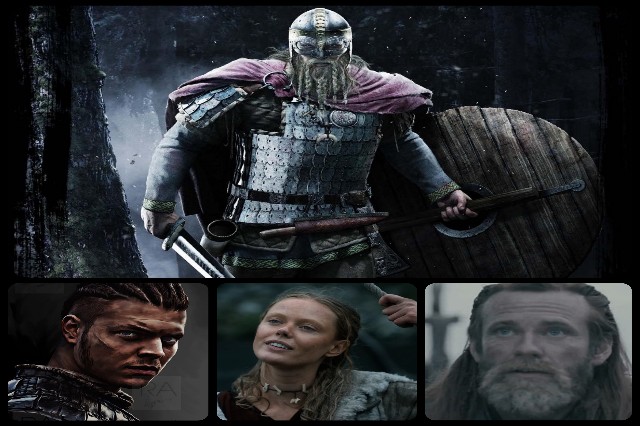Despite being renowned for their success as traders, settlers, and explorers, the Vikings are perhaps best known for their notorious reputation for v*lence and warfare. Although the Vikings had many other noteworthy qualities, they also produced some of the most formidable warriors in history. Our list of the top five f*ercest Viking fighters excludes famous figures like Ragnar Lothbrok and his brother Rollo, who are already known for their fer*city but includes five other warriors who were equally formidable and should not be underestimated.
4) IVAR THE BONELESS

From a movieMuch of what we know about Ivar the Boneless is based on legend. According to the tales, he was the youngest son of Ragnar Lothbrok and earned his nickname due to a medical condition that made his bones fragile and easily breakable. Despite his physical challenges, he managed to establish himself as a fearsome warrior. In Norse sagas, he is often depicted leading his brothers into battle while seated on a shield or a stretcher and wielding a bow.
After King Ælla of Northumbria k*lled his father by throwing him into a pit filled with venomous snakes, Ivar and his siblings formed an army called the Great Heathen Army and invaded England in 865 AD to seek revenge.
In 866, Ivar’s army captured York and in the following year, they captured King Ælla. Some accounts suggest that they executed him through a Norse r*tual known as the blood eagle, in which an eagle shape was carved into the victim’s back, their ribs were severed from their spine, and their lungs were pulled out and spread to resemble wings. However, historians debate whether this practice was real or a creation of the Nordic sagas.
Ivar continued to pillage and rampage across parts of England and Scotland until he settled in Dublin, Ireland, as the king of the Norsemen of all Ireland and Britain. Unlike many of his fellow Vikings, Ivar is believed to have lived to an old age before passing away.
3) FREYDÍS EIRÍKSDÓTTIR

From a movie
Freydís, daughter of Erik the Red, inherited her family’s inclination towards v*olence. Like her father, she also reportedly traveled to Vinland (Newfoundland, North America).
While exploring the area, Freydís and her party were attacked by Native Americans, causing many of her companions to flee. However, Freydís was said to have picked up a sword from a fallen Viking, bared one br*ast, and beat the sword against it before letting out a fierce battle cry. According to the sagas, she then proceeded to single-handedly win the fight, even though she was eight months pregnant, proving that Viking women could be just as formidable warriors as men.
Another saga describes her more r*thless side while exploring Vinland with her husband and two business partners, who were brothers. Tensions soon arose between Freydís and the two brothers, who had settled in different areas of Vinland. Freydís then falsely accused the brothers of beating her and demanded her husband k*ll them. She threatened to divorce him if he refused. He then led his men and they k*lled the brothers and all the men in their camp, sparing only the five women present and stopping short of a complete massacre.
Freydís demanded that all the women be slaughtered, but when her husband refused, she grabbed an axe and m*rdered them herself. In the end, her brother Leif spared her any punishment for the k*llings, but according to legend, she and her descendants were forever ostracized.
2) ERIK THE RED

From a movie
Erik the Red, a Viking known for his bloodthirsty ways, achieved notoriety for his v*olent exploits throughout his life. Erik was born in Norway, and his moniker was likely derived from the color of his hair and beard, though it could also have reflected his aggress*ve tendencies. Erik’s family was forced to flee Norway when his father was banished after committing m*rders.
Early in Iceland, Erik’s v*olent tendencies were on display when he was temporarily exiled for k*lling two neighbors who had k*lled his slaves. Upon his return from exile to retrieve his belongings, Erik engaged in yet another ruthless k*lling spree.
Despite his v*olent reputation, Erik was able to establish the first settlement in Greenland around 982 AD, and is credited with its discovery. He convinced many Icelanders to follow him to Greenland, but only 14 of the 25 ships survived the journey, with around 500 settlers founding a colony that endured until the mid-15th century.
Erik eventually succumbed to an epidemic that swept through the colony, after his son, Leif Erikson, had embarked on a journey that would establish him as one of the first Europeans to reach North America.
1 HARALD HARDRADA

Harald Hardrada, whose name meant “Hard Ruler,” was drawn to v*olence from an early age. As a teenager, he engaged in a bloody power struggle alongside his half-brother Olaf against King Cnut the Great, but they were defeated and Harald was forced into exile.
During his wanderings, Harald joined the Varangian Guard, an elite force of mostly Norse fighters tasked with protecting the Byzantine Empire. His prowess as a warrior quickly earned him a reputation for brutal*ty and a “talent for war.”
Harald was known for being cold, ruthless, and driven by ambition. He accumulated great wealth before turning his attention to Norway, where Olaf’s son Magnus had recently become king. The two agreed to co-rule, but Magnus died the following year, leaving Harald as the sole ruler in 1046.
After crushing any opposition to his reign, Harald set his sights on the English throne and launched an audacious invasion in September 1066. Though initially successful, Harald was ultimately defeated by Harold II’s forces at the Battle of Stamford Bridge. During the battle, Harald fought with the ferocity of a berserker, but he had no body armor and was struck by an arrow to the throat. Harald’s death marked the end of the Viking Age, and he is remembered as the last great Viking ruler.
